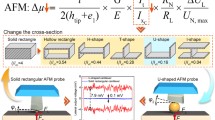Abstract
For the friction measurements with AFM/FFM, usually the relative values of friction signal can be obtained. In order to compare the micro-tribological properties of different samples, mica is often used as an reference sample for friction measurement. However, due to the friction force of new cleaved mica surface is unstable, it is urged to systematically investigate the tribological properties of mica to design the experimental rules of the reference sample mica for friction measurements. Experimental results show that the friction of mica varies with the cleaving time, humidity and surface state of tip. The friction measured with different tips on mica varies in the range of ±15%. For a new tip, the friction increases with the tip’s wear and then becomes stable. For new cleaved mica, the friction increases within the first two hours and then keeps unchanged. The friction of mica also decreases with the relative humidity because of its hydrophilicity.
Similar content being viewed by others
References
Carpick, R. W., Salmeron, M., Scratching the surface: Fundamental investigations of tribology with atomic force microscopy, Chemical Reviews, 1997, 97(4): 1163.
Hu, J., Xiao, X. D., Ogletree, D. F. et al., Atomic scale friction and wear of mica, Surface Science, 1995, 327: 358.
Shi Bing, Qian Linmao, Wang Jihui et al., Microtribological studies of C60-PST LB films using AFM/FFM, Chinese J. of Materials Research, 1997, 11(4): 346.
Shi Bing, Luo Jianbin, Lu Xinchun, Study on the synthesis, preparation of LB film and tribological properties of PS-PEO and PEOX, 26th Leeds-Lyon Symposium on Tribology, 14th–17th, Sept., 1999, Leeds.
Guruz, M. U., Yu, Y. H., Dravid, V. P. et al., Synthesis and corrosion performance of ultrathin carbon nitride overcoats, Proc. of the Symposium on Interface Tribology Towards 100 Gbit/in (eds. Singh B., Polycarpou, A. A., Menon, A. K.), 1999, 47–51.
Luo Jianbin, Wen Shizhu, Lawrence Li et al., Progresses and problems in nano-tribology, Chinese Science Bulletin, 1998, 43(5): 369.
Krim, J., Friction at the atomic scale, Scientific American, 1996, 10: 74.
Qian Linmao, Lu Xinchun, Luo Jianbin et al., Quantitative calibration of friction force microscope, Chinese Lubrication Engineering, 1997, 3: 15.
Tian, F., Xiao, X. D., Loy, M. T. et al., Humidity and temperature effect on frictional properties of mica and alkylsilane monolayer self-assembled on mica, Langmuir, 1999, 15(1): 244.
Qian Linmao, Luo Jianbing, Wen Shizhu et al., Study on material transfer from sample surfaces to AFM/FFM tips, J. of Tsinghua University, 2000, 40(4): 22.
Wan Kai-Tak, Smith D. T., Brian, R. L., Fracture and contact adhesion energies of mica-mica, silica-silica, and mica-silica interfaces in dry and moist atmospheres, J. Am. Ceramic Soc., 1992, 75(3): 667.
Author information
Authors and Affiliations
About this article
Cite this article
Qian, L., Luo, J., Wen, S. et al. The experimental rules of mica as a reference sample of AFM/FFM measurement. Chin.Sci.Bull. 46, 349–352 (2001). https://doi.org/10.1007/BF03187202
Received:
Issue Date:
DOI: https://doi.org/10.1007/BF03187202




